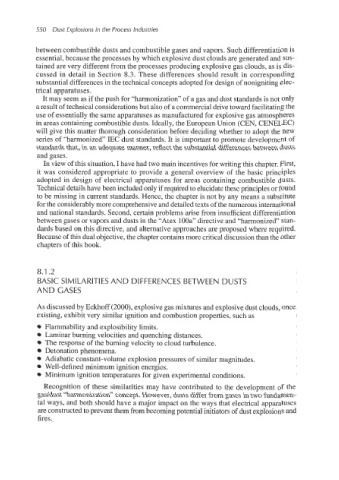Page 583 - Dust Explosions in the Process Industries
P. 583
550 Dust Explosions in the Process Industries
between combustible dusts and combustible gases and vapors. Such differentiation is
essential, because the processes by which explosive dust clouds are generated and sus-
tained are very different from the processes producing explosive gas clouds, as is dis-
cussed in detail in Section 8.3. These differences should result in corresponding
substantial differences in the technical concepts adopted for design of nonigniting elec-
trical apparatuses.
It may seem as if the push for “harmonization”of a gas and dust standardsis not only
a result of technical considerationsbut also of a commercial drive toward facilitatingthe
use of essentially the same apparatuses as manufactured for explosive gas atmospheres
in areas containing combustible dusts. Ideally, the European Union (CEN, CENELEC)
will give this matter thorough consideration before deciding whether to adopt the new
series of “harmonized” IEC dust standards. It is important to promote development of
standards that, in an adequate manner, reflect the substantial differences between dusts
and gases.
In view of this situation,I have had two main incentivesfor writing this chapter. First,
it was considered appropriate to provide a general overview of the basic principles
adopted in design of electrical apparatuses for areas containing combustible dusts.
Technical details have been included only if required to elucidatethese principles or found
to be missing in current standards. Hence, the chapter is not by any means a substitute
for the considerably more comprehensiveand detailed texts of the numerous international
and national standards. Second, certain problems arise from insufficient differentiation
between gases or vapors and dusts in the “Atex 100a” directive and “harmonized”stan-
dards based on this directive, and alternative approaches are proposed where required.
Because of this dual objective, the chapter contains more critical discussionthan the other
chapters of this book.
8.1.2
BASIC SIMILARITIESAND DIFFERENCES BETWEEN DUSTS
AND GASES
As discussedby Eckhoff (2000),explosive gas mixtures and explosivedust clouds, once
existing, exhibit very similar ignition and combustion properties, such as
Flammability and explosibility limits.
Laminar burning velocities and quenching distances.
The response of the burning velocity to cloud turbulence.
Detonation phenomena.
Adiabatic constant-volume explosion pressures of similar magnitudes.
Well-defined minimum ignition energies.
Minimum ignition temperatures for given experimental conditions.
Recognition of these similarities may have contributed to the development of the
gaddust “harmonization”concept. However, dusts differ from gases in two fundamen-
tal ways, and both should have a major impact on the ways that electrical apparatuses
are constructedto prevent them from becoming potential initiatorsof dust explosions and
fires.

